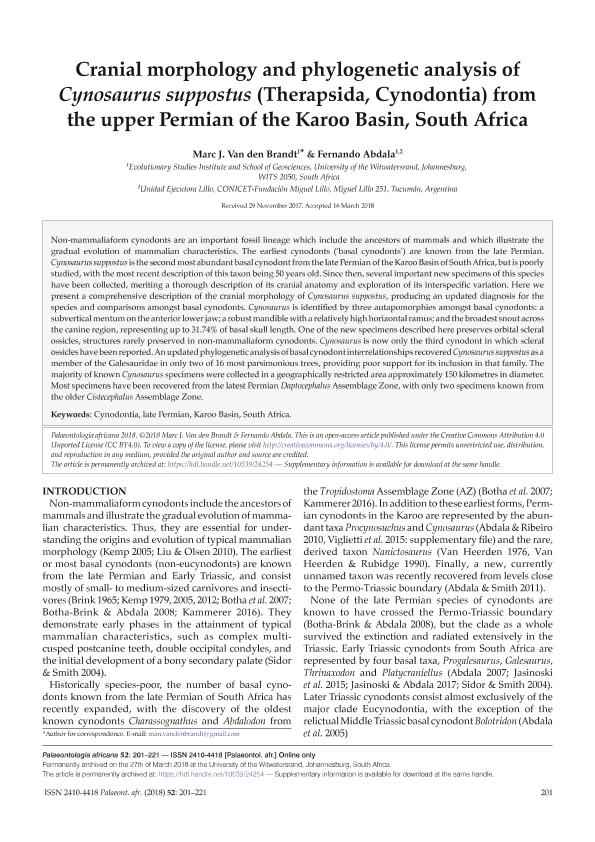Mostrar el registro sencillo del ítem
dc.contributor.author
Van den Brandt, M.
dc.contributor.author
Abdala, Nestor Fernando

dc.date.available
2019-10-17T16:01:34Z
dc.date.issued
2018-03
dc.identifier.citation
Van den Brandt, M.; Abdala, Nestor Fernando; Cranial morphology and phylogenetic analysis of Cynosaurus suppostus (Therapsida, Cynodontia) from the Upper Permian of the Karoo Basin, South Africa.; Evolutionary Studies Institute; Palaeontologia Africana; 52; 1; 3-2018; 201-221
dc.identifier.issn
2410-4418
dc.identifier.uri
http://hdl.handle.net/11336/86153
dc.description.abstract
Non-mammaliaform cynodonts are an important fossil lineage which include the ancestors of mammals and which illustrate thegradual evolution of mammalian characteristics. The earliest cynodonts (?basal cynodonts?) are known from the late Permian.Cynosaurus suppostus is the second most abundant basal cynodont from the late Permian of the Karoo Basin of SouthAfrica, but is poorlystudied, with the most recent description of this taxon being 50 years old. Since then, several important new specimens of this specieshave been collected, meriting a thorough description of its cranial anatomy and exploration of its interspecific variation. Here wepresent a comprehensive description of the cranial morphology of Cynosaurus suppostus, producing an updated diagnosis for thespecies and comparisons amongst basal cynodonts. Cynosaurus is identified by three autapomorphies amongst basal cynodonts: asubvertical mentum on the anterior lower jaw; a robust mandible with a relatively high horizontal ramus; and the broadest snout acrossthe canine region, representing up to 31.74% of basal skull length. One of the new specimens described here preserves orbital scleralossicles, structures rarely preserved in non-mammaliaform cynodonts. Cynosaurus is now only the third cynodont in which scleralossicles have been reported.Anupdated phylogenetic analysis of basal cynodont interrelationships recovered Cynosaurus suppostus as amember of the Galesauridae in only two of 16 most parsimonious trees, providing poor support for its inclusion in that family. Themajority of known Cynosaurus specimens were collected in a geographically restricted area approximately 150 kilometres in diameter.Most specimens have been recovered from the latest Permian Daptocephalus Assemblage Zone, with only two specimens known fromthe older Cistecephalus Assemblage Zone.
dc.format
application/pdf
dc.language.iso
eng
dc.publisher
Evolutionary Studies Institute
dc.rights
info:eu-repo/semantics/openAccess
dc.rights.uri
https://creativecommons.org/licenses/by-nc-sa/2.5/ar/
dc.subject
CYNODONTIA
dc.subject
LATE PERMIAN
dc.subject
KAROO BASIN
dc.subject.classification
Paleontología

dc.subject.classification
Ciencias de la Tierra y relacionadas con el Medio Ambiente

dc.subject.classification
CIENCIAS NATURALES Y EXACTAS

dc.title
Cranial morphology and phylogenetic analysis of Cynosaurus suppostus (Therapsida, Cynodontia) from the Upper Permian of the Karoo Basin, South Africa.
dc.type
info:eu-repo/semantics/article
dc.type
info:ar-repo/semantics/artículo
dc.type
info:eu-repo/semantics/publishedVersion
dc.date.updated
2019-10-16T19:13:40Z
dc.journal.volume
52
dc.journal.number
1
dc.journal.pagination
201-221
dc.journal.pais
Sudáfrica

dc.journal.ciudad
Johannesburgo
dc.description.fil
Fil: Van den Brandt, M.. University of the Witwatersrand; Sudáfrica
dc.description.fil
Fil: Abdala, Nestor Fernando. Consejo Nacional de Investigaciones Científicas y Técnicas. Centro Científico Tecnológico - Tucumán. Unidad Ejecutora Lillo; Argentina
dc.journal.title
Palaeontologia Africana
dc.relation.alternativeid
info:eu-repo/semantics/altIdentifier/url/http://wiredspace.wits.ac.za/handle/10539/24254
Archivos asociados
